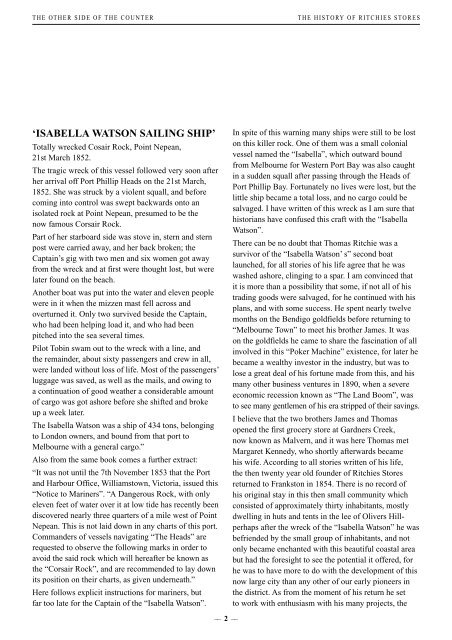THE OTHER SIDE OF THE COUNTER - Ritchies Supermarkets
THE OTHER SIDE OF THE COUNTER - Ritchies Supermarkets
THE OTHER SIDE OF THE COUNTER - Ritchies Supermarkets
Create successful ePaper yourself
Turn your PDF publications into a flip-book with our unique Google optimized e-Paper software.
<strong>THE</strong> O<strong>THE</strong>R <strong>SIDE</strong> <strong>OF</strong> <strong>THE</strong> <strong>COUNTER</strong> <strong>THE</strong> HISTORY <strong>OF</strong> RITCHIES STORES<br />
‘ISABELLA WATSON SAILING SHIP’<br />
Totally wrecked Cosair Rock, Point Nepean,<br />
21st March 1852.<br />
The tragic wreck of this vessel followed very soon after<br />
her arrival off Port Phillip Heads on the 21st March,<br />
1852. She was struck by a violent squall, and before<br />
coming into control was swept backwards onto an<br />
isolated rock at Point Nepean, presumed to be the<br />
now famous Corsair Rock.<br />
Part of her starboard side was stove in, stern and stern<br />
post were carried away, and her back broken; the<br />
Captain’s gig with two men and six women got away<br />
from the wreck and at first were thought lost, but were<br />
later found on the beach.<br />
Another boat was put into the water and eleven people<br />
were in it when the mizzen mast fell across and<br />
overturned it. Only two survived beside the Captain,<br />
who had been helping load it, and who had been<br />
pitched into the sea several times.<br />
Pilot Tobin swam out to the wreck with a line, and<br />
the remainder, about sixty passengers and crew in all,<br />
were landed without loss of life. Most of the passengers’<br />
luggage was saved, as well as the mails, and owing to<br />
a continuation of good weather a considerable amount<br />
of cargo was got ashore before she shifted and broke<br />
up a week later.<br />
The Isabella Watson was a ship of 434 tons, belonging<br />
to London owners, and bound from that port to<br />
Melbourne with a general cargo.”<br />
Also from the same book comes a further extract:<br />
“It was not until the 7th November 1853 that the Port<br />
and Harbour Office, Williamstown, Victoria, issued this<br />
“Notice to Mariners”. “A Dangerous Rock, with only<br />
eleven feet of water over it at low tide has recently been<br />
discovered nearly three quarters of a mile west of Point<br />
Nepean. This is not laid down in any charts of this port.<br />
Commanders of vessels navigating “The Heads” are<br />
requested to observe the following marks in order to<br />
avoid the said rock which will hereafter be known as<br />
the “Corsair Rock”, and are recommended to lay down<br />
its position on their charts, as given underneath.”<br />
Here follows explicit instructions for mariners, but<br />
far too late for the Captain of the “Isabella Watson”.<br />
–– 2 ––<br />
In spite of this warning many ships were still to be lost<br />
on this killer rock. One of them was a small colonial<br />
vessel named the “Isabella”, which outward bound<br />
from Melbourne for Western Port Bay was also caught<br />
in a sudden squall after passing through the Heads of<br />
Port Phillip Bay. Fortunately no lives were lost, but the<br />
little ship became a total loss, and no cargo could be<br />
salvaged. I have written of this wreck as I am sure that<br />
historians have confused this craft with the “Isabella<br />
Watson”.<br />
There can be no doubt that Thomas Ritchie was a<br />
survivor of the “Isabella Watson’ s” second boat<br />
launched, for all stories of his life agree that he was<br />
washed ashore, clinging to a spar. I am convinced that<br />
it is more than a possibility that some, if not all of his<br />
trading goods were salvaged, for he continued with his<br />
plans, and with some success. He spent nearly twelve<br />
months on the Bendigo goldfields before returning to<br />
“Melbourne Town” to meet his brother James. It was<br />
on the goldfields he came to share the fascination of all<br />
involved in this “Poker Machine” existence, for later he<br />
became a wealthy investor in the industry, but was to<br />
lose a great deal of his fortune made from this, and his<br />
many other business ventures in 1890, when a severe<br />
economic recession known as “The Land Boom”, was<br />
to see many gentlemen of his era stripped of their savings.<br />
I believe that the two brothers James and Thomas<br />
opened the first grocery store at Gardners Creek,<br />
now known as Malvern, and it was here Thomas met<br />
Margaret Kennedy, who shortly afterwards became<br />
his wife. According to all stories written of his life,<br />
the then twenty year old founder of <strong>Ritchies</strong> Stores<br />
returned to Frankston in 1854. There is no record of<br />
his original stay in this then small community which<br />
consisted of approximately thirty inhabitants, mostly<br />
dwelling in huts and tents in the lee of Olivers Hillperhaps<br />
after the wreck of the “Isabella Watson” he was<br />
befriended by the small group of inhabitants, and not<br />
only became enchanted with this beautiful coastal area<br />
but had the foresight to see the potential it offered, for<br />
he was to have more to do with the development of this<br />
now large city than any other of our early pioneers in<br />
the district. As from the moment of his return he set<br />
to work with enthusiasm with his many projects, the


